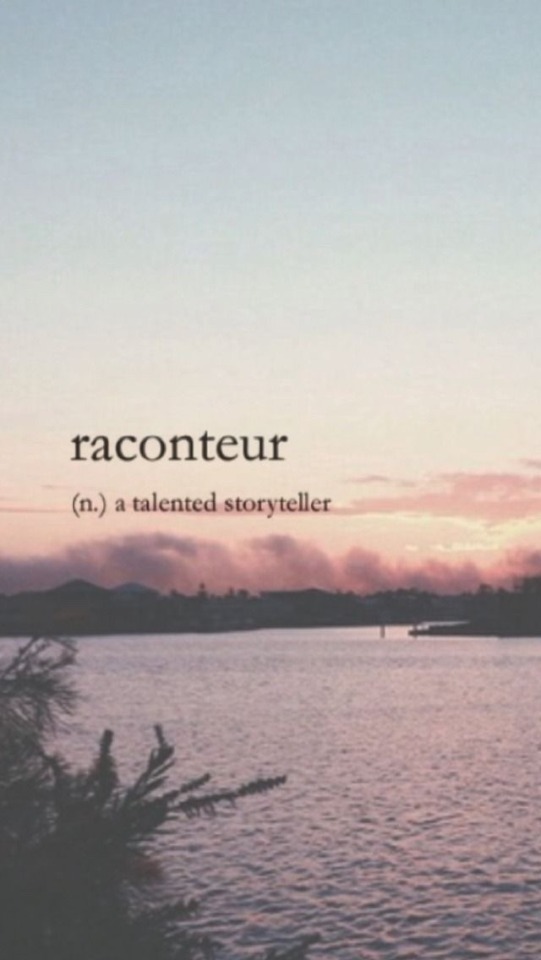#raconteur
Text
Raconteur
What if Humanity was the first to find the Citadel before anyone else?
A close guarded secret Humanity had always kept close, is just how much they understood what the beacons had to show. Warnings... constant warnings. A lot of it still did not make sense, but paranoia got the best of humanity early on. Prompting the need to locate for more clues.
For more evidence.
The beacons... what are they showing humanity?
Warnings?
Warnings of what?
Humanity being humanity... they did what any human would do.
Copious amount of alcohol, determination and spite... resulted with finding another beacon on Mars. It was there they found a cache that led them to a frozen Mass Relay once thought to be Pluto's moon. The next step, locate more beacons.
In their search, they found an occupied Citadel with Keepers roaming about.

Master List:
Here > Beginning
#Raconteur#Mass Effect#humans are deathworlders#humans are space oddities#humans are space orcs#Beginning of a Spectre Garrus Vakarian Au.
110 notes
·
View notes
Text
I was seduced through my ear. The more he talked, the more I wanted him, and he talked up a storm . . .
Siri Hustvedt, from The Blindfold
#want#desire#seduction#talking#verbose#raconteur#sexy#reminds me of#conversations with friends#falling in love#relatable#quotes#lit#words#excerpts#quote#literature#siri hustvedt#the blindfold#intellectual#romance novel inspo#fanfic inspo#character inspo
10 notes
·
View notes
Text
The lesson of Powerball
From Black Pearls Journal:
POWER
“There does not have to be powerlessness. The power is within ourselves.” Faye Wattleton
My margin note to above:
POWER Ball winner: 111 million to a guy who looks like Quentin Crisp and who already had 17 million!
On this day, I think that the lesson of Power ball is:
Enjoy. In-joy what you got! Huge amounts of money tend to diminish our lives. Especially, the day after Christmas. The invitation is to Sing. To dance. With what you got.
12/26/2002
Note:
Quentin Crisp, who was born on Christmas Day in 1908, was a gay icon raconteur. He wrote a memoir called The Naked Civil Servant, as he had been an artist’s model. He died in 1999.
A raconteur is a person who tells anecdotes in a skillful and amusing way
Power ball was a game in the California State Lottery. Pay a dollar. Buy a ticket. Win 111 million.
#Black Pearl Journal#Power#Powerball#Quentin Crisp#journaling#writing#12/26/2002#enjoy what you have#raconteur
2 notes
·
View notes
Photo

Illustration for @raconteur.stories ‘Future of Retail & Ecommerce ‘ #thefuture #futureofecommerce #raconteur #illustration #drawing #runefisker (at Copenhagen) https://www.instagram.com/p/CnjtpUOsucj/?igshid=NGJjMDIxMWI=
15 notes
·
View notes
Text

#Calamity Jane#is a legend from Wild West. She was known as a sharpshooter#raconteur#and frontierswoman. She was known to be a hard-drinking crossdresser as she always preferred to dress like a man. She was one of the most p#sandboxvet#oldschool
14 notes
·
View notes
Text

A wooden netsuke of a raconteur, made by Ōhara Mitsuhiro (1810-1875 CE).
3 notes
·
View notes
Text
i feel like drunk emma would be arguing with sober regina about whether water is wet or not. and when regina is starting to explain about molecules (because this woman is an absolute chemistry nerd™️) emma just says "well if water is not wet then is it dry???????" and regina puts a sleeping curse on herself
3 notes
·
View notes
Video
youtube
The singer songwriter, poet and folk musician Jackie Leven was born on June 18th 1950.
Born as Alan Moffatt in Kirkcald in the Pictish region he called "the Kingdom of Fife," a few miles southwest of the River Leven to a London-Irish father and Northumbrian mother, both Romany Gypsies, he was an outsider from birth. His mother played blues records around the house, and by 16 Jackie was playing in local folk clubs, and briefly married.
Though a prize-winning pupil at school (where Gordon Brown was in his year), he claimed he was the first Scots student expelled for drug-taking. A vendetta by a local gang forced him to flee Fife aged 17. During the late 1960s, he spent months huddled homeless around London's South Bank, and worked as a labourer in Kerry, Berlin and Madrid, where he recorded his first album, Control (1971), under the pseudonym John St Field. He also once mentioned he had married a millionairess.
He met his Doll by Doll bandmates while squatting Dorset farmhouses in the early '70s. "In some respects the best days of our lives, in a wonderful dream of Old England," he recalled. They reconvened in 1975, in a west London squat, Bristol Gardens, a street with "a huge contingent of badly damaged, but nevertheless wonderful fun Scottish guys ... prostitutes and petty thieves".
Doll by Doll carried their own "serious unresolved edges". Leven had a near-fatal overdose before they made Remember in 78, a blunt instrument of a debut which approximated their confrontational live act. "I can remember a couple of nights at the Marquee where I would have given anything to be in that audience," he recalled. "At the same time, there were people thinking, 'If I don't get away from this band right now, I might literally go insane.'"
Their second album, Gypsy Heart in 1979, was Leven's lyrical breakthrough. Its romantic Celtic soul music explored what would become enduring themes: identity, wanderlust and landscape. "I've never had my own place to live, I've always ended up living at other people's, and that continues to this day," he said in a 2007 interview. "But that record made me feel I had a place in the world, even if it was a very unpleasant place that wasn't going to do me any favours."
Record-company politics and their own unstable natures did for Doll by Doll after two more albums. In 1983, Leven was strangled and had his throat slashed in a mugging. Unable to speak or sing for over a year and dropped by his label, he found solace in heroin. He would sit for weeks in Marylebone station, silent and profoundly depressed.
Recovering in 1985 via acupuncture and "psychic healing", he co-founded the CORE Trust, a charity which offers holistic help for addiction. Through it, he met Princess Diana. Moving to Scotland's West Coast, he soaked up the "fierce warmth" of trawlermen in the bars at night, and began to write again.
In 1994, he returned to music with The Mystery of Love is Greater Than the Mystery of Death, the first of 24 albums for Cooking Vinyl. These formed a prolific, redemptive songbook about a cruel world, often sung and played with deceptive lightness. His own partial healing, and 1990s fascination with the "Iron Man" philosophy of Robert Bly, gave him new perspective on the scarred tough men of great songs such as "Classic Northern Diversions". He settled happily in Hampshire with his long-term partner Deborah Greenwood, but each year he took a sleeping bag, and wandered country lanes again. "My missus says, 'Jackie, you're a vagabond and I accept that'," he said. To me it must have been that Romany blood he inherited.
In concert he was a charismatic troubadour. Settling at the bar for a pint before the gig, he'd then leaven his songs with dryly hilarious tall tales. Four live albums released in 2009, under the general heading "The Haunted Year", give the fullest picture of his work. A yarn where he announces Sting's death on a Kirkaldy commuter train is inseparable from the songs. His last album, Wayside Shrines and the Code of the Travelling Man, was released in 2011, during which he continued to tour, until the cancer which killed him made it impossible. "I sometimes think I'm too connected to the pain of other people," he once said, unsure if this was a good thing. "Out of that, and anger about that, I find myself writing." This sympathy for often violent, stoic people who were rarely offered it had, in his finest songs, few parallels.
Leven died on 14 November 2011, aged 61, of cancer. Ever the performer and knowing he was dying, Leven had been due to perform at the Green Hotel in Kinross for Mundell Music on Friday night 18 November.
I’ve chosen a great song by Jackie call Exit Wound, I first heard this after reading the Ian Rankin Rebus novel, by the same name in 2008, Ian was a big fan of Jackie’s, I know this is the part of the post where most people move on and don’t bother listening to the song, but I implore you, please for a change have a listen to it, Jackie Leven is one of the most underrated geniuses of the Scottish music scene.
"If you could look inside my heart
You'd see a body without a soul"
Deserted villages - forget-me-nots
Blowing in the cold
"If you could look inside my heart
You'd see a body without a soul"
Deserted villages - forget-me-nots
Blowing in the cold
It was the time of spring and song
The lilac had already been and gone
I had just returned from walking
By the sounding sea
I came back from the hotel
Where you turned and said to me
White bars of heaven keep me from you
I know you're living in hell, but what can I do
White bars of heaven keep me from you
I know you're living in hell, but what can I do
I stood under the shattered star
And watched the drunks fall by
With every stumble that I saw
A picture cleared in my mind's eye
I see you walk away with your heels
Sparking on the ground
And though I lie alone
I feel your fingers deep inside
My exit wound
Now I have been on your side so strong
Though something in your kiss was all wrong
And now you say there's something
Something wrong inside my mind
You're gonna let me go
I hear you whisper from behind
8 notes
·
View notes
Text

Francisca 'Frankie' Shepard
Frankie Shepard, born in a timeline where Humanity were the first to discover the Citadel. That comes along with humans dealing with the chaos of first meetings and well.... a drastic fashion change that has them dressed in 80s/90's punk esthetics....
Their technology may be far advanced than other species, but their choice of fashion did change... for the better many will say.
Shout out to @redreart!!! Amazing as always!!! Her work is amazing go check her out!!!!!!!!!!!!!!!!!!!!!
Frankie Shepard: Masterlist
#Frankie Shepard#art commisions#Art#ME#mass effect legendary#Mass Effect#AU#humans are space oddities#humans are deathworlders#raconteur
30 notes
·
View notes
Text
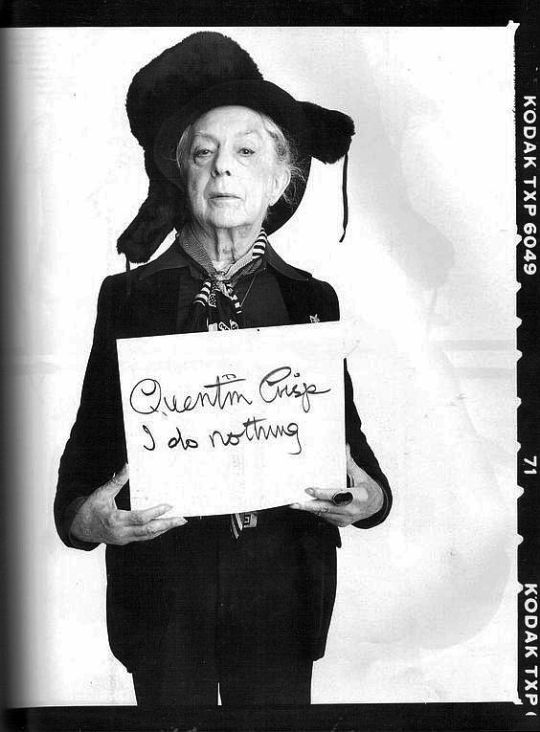
Quentin Crisp, 1992, photographed by Steven Meisel
1 note
·
View note
Text
#6070
Raconteur amidst the grime,
Grant us many stories in rhyme
That last more than a lifetime.
1 note
·
View note
Text
just saw on the hbomb subreddit that james somerton briefly reactivated his twitter and changed the name to agayraconteur, then 8 hrs later deleted it again because people were noticing, so. everyone who went all in on "he'll keep popping up again and again in new forms" cash your bets in now LMAO
edit: hey yall this post is very out of date but has been getting spikes of notes since the second apology video so i'm gonna be marking it unrebloggable
#james somerton#google tells me a raconteur in someone who tells anecdotes in a skillful and amusing way#which uh. wrong on literally all 3 counts#or well i guess google doesnt specify that it has to be your own anecdotes so i guess he gets one out of three on a technicality#bigger gibbers
12K notes
·
View notes
Text
i’m constantly reminded of mortality, and it doesn’t bother me the way you’d think
repost from that time i deleted an article i spent 4 days on T-T
actual post this time since i somehow posted it privately yesterday 😭
---
Hi, I’m Questioning. And I like to waste my life away dedicate my free time to random hobbies that catch my hyperfixation interest on the fly. Currently, I’ve returned to something most important. Updating the encyclopedia-esque database of AlternativeTo.net. o_o

Let me finish.
See, I started exploring the world of Visual Novel (VN) makers, which led to me discovering the world of Interactive Fiction (IF)–their predecessor afaic. And that’s where it got strange. What I’ve found is interesting developments in terms of innovation and such. Like Undum (image)–“a game framework for building a sophisticated form of hypertext interactive fiction” according to its GitHub. IFWiki calls it “an authoring system for CYOA-style stories playable on web browsers.” It was created by I.D. Millington in 2009, released in 2010, had returned in 2018, and would’ve changed the IF genre (kinda like Twine did) if not for how hard it was to get into.
Undum’s flexibility and power have made it the engine that drove some of the most significant works in IF (The Play, Almost Goodbye). But it has always been relatively inaccessible. Undum is not the system of choice for writing straightforward hypertext games; it’s a challenging system to learn and use that demands the author build their own engine on top of it to drive their game logic. Consider Raconteur for “Undum with batteries included.” -Bruno Dias (x)
Enter Raconteur, “a friendlier way to write Undum hypertext fiction” that was announced by Bruno Dias in 2015. More accurately described as “a library of Undum tools that can get someone writing their story quickly.” Here’s the thing about the “library of Undum tools” part: Undum did not come prepackaged with any… even though they were required to write your game,…😐 which “meant doing a lot of your own tooling.” 😑
Yeah, no surprise it won the award for Best Technological Development in XYZZY Awards 2015.
But hold up, somethin’ ain’t right…
Undum’s only got 21 games on IFDB.org and Raconteur’s got 4… with 1 overlap with Undum. 😐
So~… wth?
Well, someone else had a similar question on intfiction.org in March and got Josh Grams’ opinion on it: JavaScript.
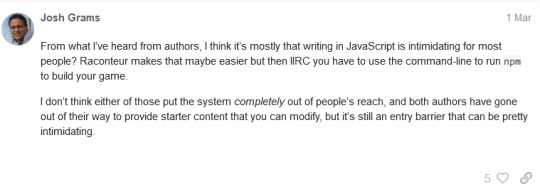
🤷🏿♂️
So even though Undum was designed as the visual version of bookbinding and with the specific goals “aesthetic” & “technical” in mind, shit’s too intimidating compared to alternatives.
I hoped [writing Undum in JavaScript] would make it accessible for a wider range of dabblers, requiring transferable skills rather than learning a new language. It also made it achievable to write and document over a few weekends: I didn’t have to worry about parsing, or creating a complete runtime. But the best benefit, and in some ways the one least exploited in practice, is the ability to use Undum as part of a bigger game. I imagined a strategy game with CYOA elements, or a piece of interactive fiction using natural language generation to be different each time. -Ian Millington (x)
And here’s~ where it gets a bit fucked.
Remember the other person who had a similar question–J. J. Guest? Well, they ended their post with “Was it simply superseded by Ink / Inky?”
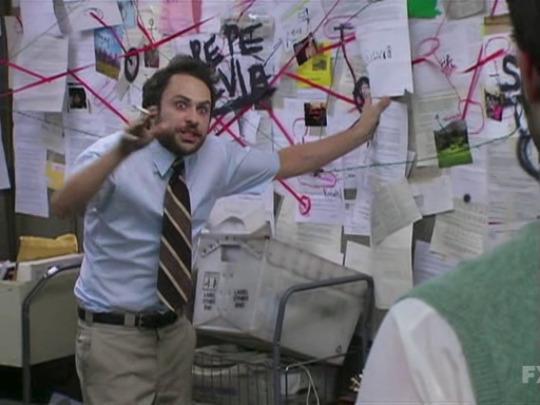
Let’s keep this simple:
Ink [image] is the core narrative engine itself, written in C#. It includes the code for the compiler. If you’re not technical, you don’t need to worry about this.
Inky [image] is our ink editor, which is a text editor with support for playing as you write. If you’re just starting out with ink, this is all you need.
inkle is the game development studio that created ink
(x)
So it’s “a narrative scripting language for games” and yet another CYOA maker. Why do I bring them up? Well, Inkle (the company) “was founded in 2011 by two Cambridge game developers [Joseph Humfrey & Jon Ingold] with a passion for storytelling and beautiful design” (x). They started off with their unique “inklebook” format, which had an early prototype game in ~2008 that Jon described as
an iPad-based choice-driven story made of ‘pages’ which stitched together into a single flow via frequent choice points. It was a lovely UI for a choice-based game, even in prototype form, and we had a strong scripting language underneath it – the first version of ink. (x)
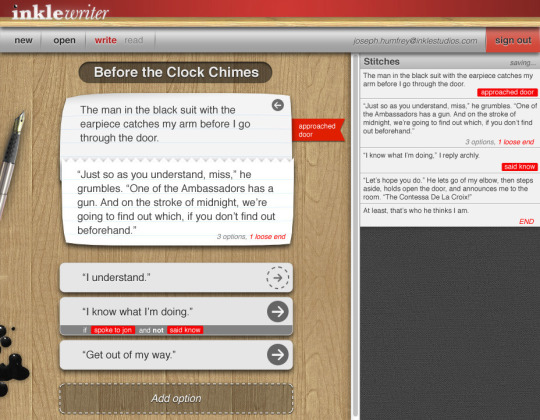
In January of 2012, they released “a web-tool for writing and reading simple interactive stories” called inklewriter. Joseph described it as “a simpler subset of the inklebook format” (x) and admitted “inklewriter was partly born out of the surprise that there isn’t anything out there for quickly and easily writing non-linearly.” (x)
After already having “moved away from developing inklewriter for a long time,” it went “permanent beta” in September of 2017 due to “increasing frequency of persistent bug-reports.” Sad news considering the statement “we’ve had hundreds of thousands of stories created by hundreds of thousands of users; we’ve won awards from school and library associations; and hopefully we’ve helped kickstart a few interactive writers careers” (x). And since writers (who became aware in time) were able to “rescue” their story from the bugs and potential wipeout with a simple Save Page As, it was probably a bit less heartbreaking when inkle revealed less than a year later that inklewriter would be shutting down completely in August of 2018. Seemingly because “it’s real work to fix the issues that arise” with the constant browser changes. 😐
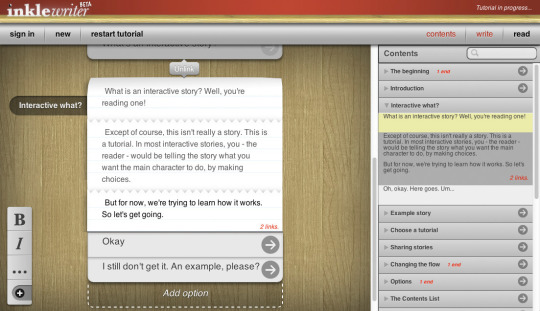
Only 7 months later, it returned in March of 2019. Stable, still free, and now open-source after developers in the open-source community “produced a full port of inklewriter to modern web-tech.” 🥳 Writers needed to make new accounts and import their stories to the new database, but that was it. And since the legacy version was (and is) still around, they could do it pretty quickly. (x)
But where dahell was I going with this? Let me tell you about the original connection first: Unity Integration.
The [ink-unity-integration] plugin provides you with everything you need to get started with ink in Unity. It automatically recompiles ink files as you edit them, and even comes with a simple previewer that lets you play stories directly within the Editor, without writing a line of code. (x)
Remember Ian Millington’s statement from awhile ago? “But the best benefit, and in some ways the one least exploited in practice, is the ability to use Undum as part of a bigger game. I imagined a strategy game with CYOA elements, or a piece of interactive fiction using natural language generation to be different each time.” (x)
Well,… Stoic Studio (announced that they) did it in January 2013 when they used inklewriter for The Banner Saga. Though, inkle recommends you use their ink scripting language instead for Unity projects. 🤷🏿♀️ A scripting language that was ported to JavaScript in May of 2016, btw. The port (inkjs) having its latest release just 6 freaking days ago while Undum and Raconteur had their last GitHub edits in 2018 & 2020 respectively.
Either way, Ian’s imagination of “a strategy game with CYOA elements” happened… with another mofo’s software. 😐
And what’s that? I left something out?
I left working on Undum to develop Varytale, a short lived commercial IF endeavour that shared a lot of the same aesthetic and narrative structure. And then I retired, and it lay fallow, aside from email help requests that still drip into my inbox. -Ian Millington (x)
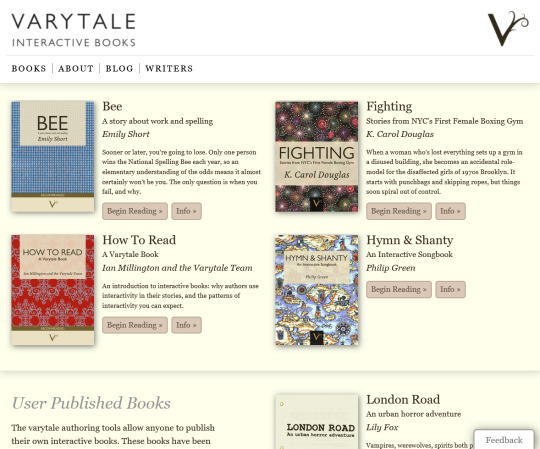
Let’s see what IFWiki says about this endeavor:
Varytale was a platform for authoring and publishing browser-based CYOA, created by Ian Millington and Alexis Kennedy; it occupied a point somewhere between Undum and StoryNexus [a comparatively mostly defunct endeavor from 2012].
The Varytale website was live from approximately 2011 to 2015. The first posts on Varytale’s blog appeared in June 2011. On March 7, 2014, Varytale posted a comment on the Varytale Facebook page saying, “The project is stalled, due to key people leaving the project. So there’s no news, and I’m not sure if or when there will be.” The last Wayback Machine snapshot of www.varytale.com/books was taken in September 2015. (x)
On its May of 2012 public beta announcement on FailbetterGames website, something slightly poignant was said.
But the technology is great [seriously] - it’s easily the most flexible and powerful tool of its kind, and it’ll be fascinating to see what people can do with it once the writers’ programme opens up.
And as it happens, Jon Ingold / Joseph Humfrey’s very elegant inklewriter has also just gone live [4 months prior].
(…)
…[inklewriter] covers some of the same territory as Varytale, but it’s (by design) simpler in concept and execution. (x)
Life is truly cruel.
If you check the archive from possibly days before its shut down in September of 2015, you’ll see 4 official books (Bee, Fighting, How To Read, Hymn & Shanty) and 3 User Published Books (London Road, Sixth Tower, Tillinghast). That’s 7… 7 books. 😐
But it’s not that sad. According to the Varytale blog’s 2nd to last post (in June of 2012), “we passed 50,000 reads across the seven books currently on our reader’s beta.” This was perhaps a full week after they released the floodgates and actually allowed people to start readin’. Das alot to me. They clearly succeeded in “building a platform for authors to write great books, and for publishers to publish them.” Even built a whole-ass “system that does generative design,” creating “artwork based on the author’s choice of patterned design or photograph” (x). Or, as we’d quickly say 12 years later, some AI shit.
So wut 👏🏿 in da fuq 👏🏿

Why’d they never get past the 7 book mark in the 2 years between Reader’s Beta and project stallation? Well,… there’s a hint at the end of that 2012 blog post: “We have a queue of people wanting to write content, who are been added a few at a time. So lots of hard work in the beta still to go.” hm~ 🤔
If The Way Back Machine had archives past January of 2013, we’d definitely know more, but this is it (i ain’t diggin’ a wider hole at this point). And what is it? I think it’s a matter of workload. Too much for too few people who had however much goin’ on in their lives. Remember much earlier this bit from IFWiki?
On March 7, 2014, Varytale posted a comment on the Varytale Facebook page saying, “The project is stalled, due to key people leaving the project. (x)
Maybe things weren’t smooth enough for awhile. Maybe it was something else for those 2 years prior. 🤷🏿♂️ And you know… the end of Emily Short’s blog post Writing for Varytale might hold the answer.
There are still some challenges about using the Varytale system, though it’s evolved tremendously over the course of beta. One of the biggest authorial challenges is that, while there’s the awesome structure tool shown above for looking at branching structure inside a storylet, it can be considerably more challenging to get a view of what’s going on at the macro level. And I’m not even sure what the tool for this ought to look like. The strength of storylets is that they can affect which other ones pop up in a fairly freeform way, and one can affect another (via their shared stat use) without explicit logic in either.
But that’s also what makes it really hard to graph how they will act. Most of the bugs that arose in Bee were related to this issue of envisioning the total structure of the work and detecting storylets that were going to break that structure. (x)
So in this case aswell, the innovations of Ian’s Varytale make it… (a bit) intimidating to work with. 😑Whether or not this difficulty was ever ironed out post-beta is unknown to me, especially considering the end of Ian’s thankful response to Tom H.’s suggestion for fixing the macro level problem: “When will I get chance to code it? That’s a whole other matter!”
…hm~
And on the same post lies magnus4444’s statement that “There isn’t a lot of documentation out there yet on the implementation of more advanced effects but, on the plus side, Ian is generous with advice and tips.”
🤷🏿♀️
So wtf do we have here. Effectively two developers (i’m simplifying it; fight me) who 1) made a CYOA maker (Undum & inklewriter) for very similar reasons, 2) put development aside to focus on other CYOA makers (Varytale & Inky), 3) had their neglected work taken up by open-source developers for the good of everyone, and 4) reaped the benefit of the other’s labor in some way. Now, here’s where we’re back to the sad part. Inkle’s version of the tale is the American Dream ™. Inklewriter was beloved by many and had mainstream success. Ian’s version is the harsh American Reality. Undum only bore 24+ games over the course of its 13 year existence on the internet and in the world of IF. And if a single person’s opinion is to be taken as fact… then the reason was simple: shit wasn’t easy to pickup. And thus, regardless of Ian & Bruno’s efforts, it (at this rate) is bound to become an obscure software regardless of its potential. All while Varytale remains gone and Inky (released in June of 2016) is still goin’ strong with 160+ games released using its Ink language/engine.
Which brings me back to the matter…
i’m constantly reminded of [my] mortality
#article#long post#looooooooong#Undum#Raconteur#Varytale#inklewriter#inky#inkle#AlternativeTo#Visual Novel#VN#Interactive Fiction#IF#GitHub#IFWiki.org#CYOA#I.D. Millington#Bruno Dias#XYZZY#IFDB#JavaScript#Ian Millington#inklebook#Stoic Studio#The Banner Saga#inkjs#Alexis Kennedy#Emily Short#once again i'm gonna say that i think the key reason for Ian's efforts being less successful than inkle's is marketing
1 note
·
View note
Text
raconteur - a person who tells anecdotes (stories about real incidents or people) in a skillful and amusing way

1 note
·
View note
Text
Happy Birthday to Silent Bob himself, Kevin Smith!










#kevin smith#clerks#Mallrats#chasing Amy#cop out#dogma#jersey girl#tusk#jay and silent bob strike back#jay and silent bob reboot#clerks II#red state#Zack and Miri make a porno#catch and release#southland tales#clerks iii#an evening with Kevin smith#filmmaker#podcasts#raconteur#yoga hosers#reaper#clerks the animated series#Jay and silent Bob do degrassi#comic book men#masters of the universe
1 note
·
View note
